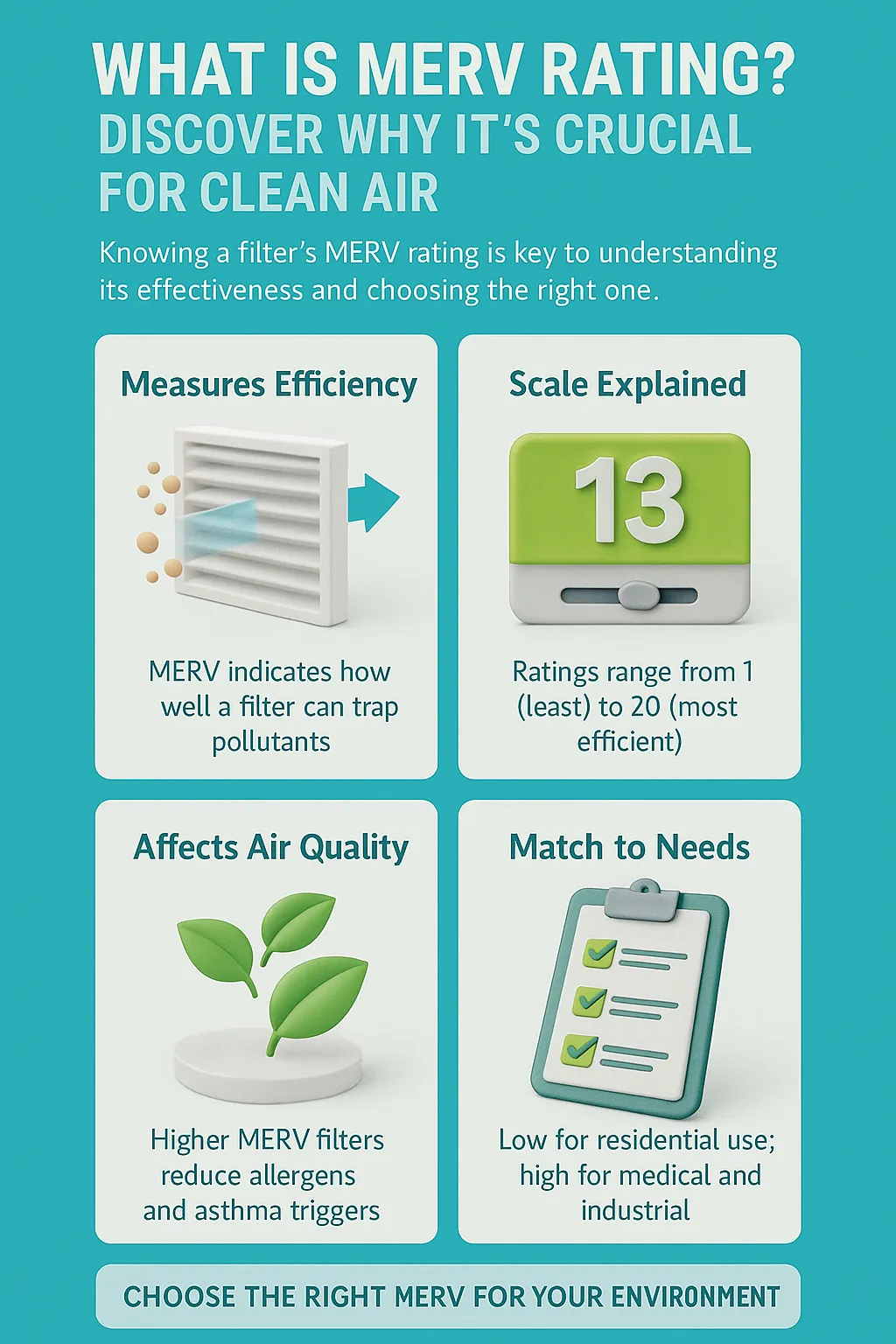Key Takeaways
MERV rating directly impacts air purity and HVAC performance
MERV 11–13 is optimal for most homes needing protection from allergens, odors, and fine dust
System compatibility matters—don’t over-restrict airflow with the wrong filter
Improving filtration = healthier breathing, cleaner homes, and energy efficiency
The Basics: What Does MERV Rating Actually Mean?
MERV stands for Minimum Efficiency Reporting Value, a scale developed by ASHRAE to rate the effectiveness of air filters. The scale ranges from 1 to 20, with higher numbers indicating finer particle filtration. A low MERV rating traps only large particles like carpet fibers or pollen. Higher ratings, particularly MERV 11–13, capture much smaller particles such as smoke, bacteria, and fine dust.
But here’s the catch: higher isn’t always better. Not all HVAC systems are designed to handle high-resistance filters. If your system isn’t rated for it, a filter with too high of a MERV rating can restrict airflow, cause system strain, and drive up energy costs.
Why It Matters: MERV Ratings and Indoor Air Health
We’ve worked with families and small businesses across the country, and the pattern is clear—many air quality issues trace back to poorly matched filters. A family suffering from seasonal allergies was using a MERV 6 filter with no improvement in symptoms. After upgrading to a MERV 11, their allergy issues significantly decreased. Similarly, a pet grooming business using MERV 8 filters dealt with strong odors and dust until switching to MERV 13—with immediate results.
The right MERV rating doesn't just improve comfort. It impacts:
Respiratory health
System efficiency
Energy savings
Long-term HVAC durability
Real-World Improvements: What We’ve Seen
Family in Atlanta, GA
Original setup: MERV 6
Solution: Switched to MERV 8
Result: 35% fewer airborne allergens and improved airflow
Dog Groomer in Denver, CO
Original setup: MERV 8 with monthly changes
Solution: Upgraded to MERV 13
Result: Less odor, cleaner vents, and better breathing comfort
Office with Limited Ventilation
Original setup: MERV 7
Solution: MERV 12 plus air purifier
Result: 42% improvement in indoor air quality and fewer sick days reported
These examples highlight a key takeaway: selecting the correct MERV rating can dramatically improve both health and HVAC performance.
Backed by Research: What the Numbers Say
Our experiences are supported by national data:
MERV 13–16 filters remove up to 95% of indoor airborne particles
AirNow.gov – Indoor Air Filtration GuideMERV 13 filters trap ≥50% of 0.3–1.0 µm particles (compared to ~20% for MERV 11)
EPA Technical SummaryBuildings using MERV 13–14 saw ~31% lower PM2.5 levels
CDC + SVACH Research
These statistics reinforce what we’ve witnessed: higher-rated filters make a measurable difference—but only when properly matched to the system.
Final Thought: Make MERV a Priority
Choosing the right MERV rating may seem like a small detail, but it plays a critical role in your home’s comfort and safety. Whether you're looking to ease allergy symptoms, improve system performance, or simply enjoy cleaner air, filter efficiency matters.
Our advice? Don’t guess—match your filter to your lifestyle and your HVAC specs. It’s one of the smartest, simplest ways to upgrade your indoor environment.
What to Do Next
Check your HVAC manual or ask a technician what MERV rating your system supports
Assess your needs—pets, allergies, or poor outdoor air quality may require MERV 11–13
Use the correct size and replace your filters every 1–3 months
If in doubt, consult a pro to avoid airflow restriction or damage
Cleaner air starts with a smarter filter—and the MERV rating is your guide.

Frequently Asked Questions (FAQ)
What is a MERV rating, and why does it matter?
MERV stands for Minimum Efficiency Reporting Value. It measures how effectively an air filter captures airborne particles. A higher MERV rating generally means cleaner air and better protection from dust, allergens, and pollutants.
Which MERV rating is best for improving indoor air quality?
For most homes, MERV 8–13 offers the best balance of filtration and airflow. MERV 11–13 filters are especially effective for removing finer particles like pollen, pet dander, and smoke, making them ideal for allergy sufferers or homes with pets.
Is a higher MERV rating always better?
Not necessarily. While higher MERV filters trap more pollutants, they can also reduce airflow if your HVAC system isn’t designed for them. It’s important to match the MERV rating to your system’s capabilities.
How can the wrong MERV rating affect my HVAC system?
Using a filter that’s too restrictive for your system can lead to poor airflow, higher energy use, and premature wear on HVAC components. Always check your system’s specifications or consult a professional before upgrading to a high-MERV filter.
How often should I replace my air filter based on the MERV rating?
Typically, every 1 to 3 months. Higher MERV filters capture more particles and may need to be replaced more frequently, especially in homes with pets, allergies, or heavy usage.
Understanding what MERV rating means is essential for anyone striving to achieve cleaner, healthier air in their home. The Minimum Efficiency Reporting Value (MERV) measures how effectively a filter captures airborne particles, playing a crucial role in indoor air quality. Pairing this knowledge with practical services like those from Air Duct Cleaning in East Palatka, FL ensures your system is working efficiently and circulating clean air. For those tackling buildup in Florida's humid climate, Vent Cleaning in Coral Springs, FL complements high-MERV filters by removing lingering contaminants. While understanding HVAC filters may seem unrelated to the ad world, agencies that break down industry topics—like Understanding Advertising Agency Compensation Models and How Is Advertising Agency Commission Calculated—serve as great examples of how clarity empowers informed decision-making, just like decoding MERV ratings empowers healthier living.






